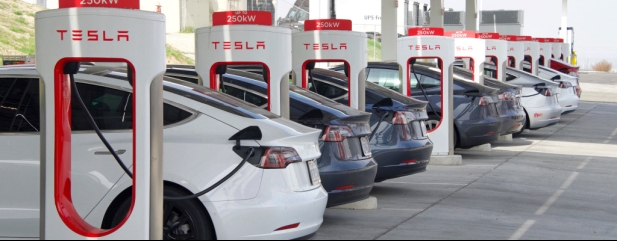Archived article
Please note that tax, investment, pension and ISA rules can change and the information and any views contained in this article may now be inaccurate.
Where do investors stand after Tesla’s 57% 2023 share price rally?

The story of Tesla (TSLA:NASDAQ) continues to astonish investors, both fans and sceptics. In the early part of 2023, the share price had all but doubled (from the start of the year to 15 Feb), followed by sharp falls from that $214.24 peak a month ago. As it stands, the stock is about 57% up year-to date at $169.98.
It’s a far cry from its pariah status of 2022 when shares in the electric cars-to-energy lost nearly 70% of their value.
The question is, what next?
A key part of Tesla’s share price advance this year has been its price cuts. In January, the company lowered the prices of two of its most popular vehicles, the Model Y and Model 3, across US and European markets by up to 20%. The company cut prices again at the start of March.
‘Our focus on continuous product improvement through original engineering and manufacturing processes have further optimised our ability to make the best product for an industry-leading cost,’ is what Tesla said in a statement at the time.
‘As we exit what has been a turbulent year of supply chain disruptions, we have observed a normalisation of some of the cost inflation, giving us the confidence to pass these through to our customers.’
As is so often the case with Tesla, investors have found themselves split over EV (electric vehicle) prices.
ARE PRICE CUTS A SIGN OF STRENGTH OR WEAKNESS?
‘How do bulls like Dan Ives or Gary Black justify improving margins when the company is cutting selling prices and inventory is up?’ asked Markets.com analyst Neil Wilson rhetorically. Dan Ives is an analyst at US broker Wedbush. Gary Black is a Future Fund managing partner and co-founder. Both are long-run champions of Tesla shares.
For the time being, investors seem willing to buy into the idea that price cuts across a number of models are not necessarily a terrible thing, if they can successfully lure Chinese buyers. The flipside is pressure on industry-leading margins which is yet to be fully reflected in Tesla’s numbers.
Investment bank Berenberg recently (8 March) downgraded its Tesla recommendation to clients from ‘buy’ to ‘hold’, admitting that Tesla’s vehicle price cuts will hit gross margins in the short run, but still sees high margins long term.
‘We see less upside in the shares after a 21% rise since our upgrade, putting them on a 1.3% free cash flow yield on our 2025 forecast,’ it said.
Interestingly, however, Berenberg’s Adrian Yanoshik increased his target price on the shares to $210, up from $200. That’s more than 20% above the $173.44 where they closed on 10 March.
The Berenberg analyst wrote that ‘misplaced fears of a price war’ appear to have been accepted by the market and that volume opportunities will increase when Tesla releases its cheaper next generation vehicle. The analyst also says Tesla’s valuation ‘now leaves less room for disappointment’.
Price cuts in the auto industry are nothing new, but they are for Tesla. The company, which historically has been unable to keep up with demand, has seen its order backlog shrink from 476,000 units in July 2022 to 74,000 in December 2022. This has been attributed to Tesla’s robust production growth, which saw 2022 production increase 41% over 2021 (from 930,422 to 1,313,851 units).
With the days of endless demand over, Tesla is going on the offensive by reducing prices, a move that puts pressure on competitors, but has also angered existing owners. Tesla’s price cuts are an attempt to protect its market share, but they’re not exactly the desperation move some media outlets have claimed them to be.
Recent data compiled by Reuters shows that Tesla’s margins are significantly higher than those of its rivals, both in terms of gross and net profit.
CHEAPER CAR PLAN WAS LIGHT ON DETAIL
The four-hour Tesla presentations marathon at its investor day on 1 March was meant to get investors excited but many were left disappointed, lots of talk but little detail. We know Tesla wants to drastically reduce manufacturing cost and complexity to create cheaper cars, which it would do at the new manufacturing facility planned for Mexico.
That process would involve designing a new generation of power train that would eliminate the need for rare earth materials, cut silicon carbide supply needs by 75%, shrink factory footprints by half, and be compatible with any type of battery chemistry.
But the new car rumoured to be attached to the more efficient power train was under wraps at the presentation (it was literally shown under a sheet in the slide deck) and Tesla said it wasn’t going to share any new vehicle plans yet.
HOW DOES TESLA MAKE MONEY?
In 2022 the company derived $69.7 billion of its revenue from automotive sales and leasing and $1.8 billion from regulatory credits. In a push to reduce carbon emissions, governments globally offer credits as an incentive for carmakers to develop electric vehicles. Given this is Tesla’s sole focus in terms of cars it automatically receives these credits and can sell them at an effective 100% bottom line to rivals who must have a certain level of regulatory credits each year.
While the company doesn’t explicitly spell out the contribution of these credits to its profit, if we assume it is genuinely 100% profit, it represents around 9% of the adjusted EBITDA (earnings before interest, tax, depreciation and amortisation) for 2022 of $19.2 billion.
That leaves some $10 billion of revenue derived from the other parts of its business: Energy plus Services & Other (repair and maintenance, service plans and sales of used Tesla vehicles). Energy is the part of the business that is often overlooked, but that’s starting to change. Tesla’s ‘path to a fully renewable energy future’ is a set of ambitious goals around solar energy and power storage.
‘There is a clear path to a sustainable energy earth. It doesn’t require destroying natural habitats, or for us to be austere,’ Musk said. ‘We could support a civilisation much bigger than earth’s sustainably on earth, and I’m shocked by how few people realise this.’
The company’s slide deck, as shared on Twitter, claims that only a third of the dirty energy generated on earth ends up being consumed in a useful manner. Tesla estimates that transitioning to green energy would require an additional 240 TWh (terawatt hours) of energy storage, 30 TW of new solar or wind generation, and an additional $10 trillion to break free of fossil fuels.
If investors believe Musk’s presumptions, 2022 will not be Tesla’s Energy arm’s last record year.
Tesla Solar had a good fourth quarter with 100 MW (megawatts) deployed, but the company really shined with its energy storage deployment: Powerwalls and Megapacks. Tesla confirmed that it deployed a record 2.4 GWh (gigawatt hours) of energy storage in Q4, up 152% year-on-year and 300 MW more than the previous quarter, which was also a record.
It brings Tesla’s total deployment for the entire year to 6.5 GWh, up 64% versus 2021.
A new factory in California did contribute to the record in Q4, but the ramp-up started in the middle of the quarter, which means that the impact will be felt more in 2023 as it takes time from the production of the Megapacks to their deployments at energy storage projects.
TESLA ENERGY HITS $1 BILLION MILESTONE
Tesla Energy revenues are running at more than $1 billion a quarter for the first time, and expectations are for this to rise rapidly, much faster than costs, which will help drive gross margins way beyond the 13% to 14% earned from Energy & Storage in Q4.
Tesla shares change hands today for around 27-times last year’s $17.4 billion EBITDA. If the business is valued similarly on 2025 Berenberg EBITDA forecasts of nearly $36 billion, it would imply a market valuation of more than $1 trillion compared with around $550 billion today.
Important information:
These articles are provided by Shares magazine which is published by AJ Bell Media, a part of AJ Bell. Shares is not written by AJ Bell.
Shares is provided for your general information and use and is not a personal recommendation to invest. It is not intended to be relied upon by you in making or not making any investment decisions. The investments referred to in these articles will not be suitable for all investors. If in doubt please seek appropriate independent financial advice.
Investors acting on the information in these articles do so at their own risk and AJ Bell Media and its staff do not accept liability for losses suffered by investors as a result of their investment decisions.
Issue contents
Feature
- Investing in AIM shares for inheritance tax relief? Don’t get caught out by these issues
- Are Harbour Energy and its rivals bluffing about leaving the North Sea behind?
- Why investing in your 60s doesn't mean the end of investing for capital growth
- Lifetime ISA: top investment strategies for your first home or retirement
- How investors can take part in company fundraisings as they dial up again

 magazine
magazine








